Successful partners’ day at CIMMYT-Harare showcasing research work
The value of CIMMYT’s research work is enhanced through partnerships supporting the development and dissemination of new maize production technologies. To encourage this collaboration, the CIMMYT Southern Africa regional office in Harare, Zimbabwe, holds an annual event during which stakeholders from the ministries of agriculture, academic institutions, seed companies, and donor representatives tour field trials and get acquainted with the station’s research outputs.
On 05 April 2013, the Australian ambassador Matthew Neuhaus together with donor representatives from the European Union, AusAID, and the Swiss Agency for Development and Cooperation joined stakeholders from Zimbabwe, Mozambique, Lesotho, Swaziland, South Africa, and the Democratic Republic of the Congo for a successful partners’ day. Over 200 visitors explored CIMMYT fields, observed various products on the maize breeding pipeline such as trials on drought tolerance, nitrogen use efficiency, and demonstrations on conservation agriculture. Visitors also learned about small-scale farm mechanization for conservation agriculture and management of post-harvest losses through the use of metal silos.
During the field tour, it was evident that CIMMYT is incorporating legumes into maize production systems. This not only includes cover crop that contributes to nitrogen fixing but also grain legumes to improve diversity in the farming households’ nutrition. “CIMMYT is keen to see farmers gain more yield per unit area as opposed to having them increase the acreage under maize,” explained Mulugetta Mekuria, regional liaison officer for southern Africa. “When the maize yield is increased on a small portion of the land, the family can then use the rest of the land to grow high value crops such as pigeon peas that are being successfully exported to India from Mozambique and Tanzania,” he added.
Nutrition was a topic of other parts of the partners’ day as well. Farmers in most of the African continent prefer white maize but where diets are predominantly based on maize, especially with weaned infants, nutritional deficiencies may arise. Two exciting options for overcoming such nutritional deficiencies are quality protein maize (QPM) and vitamin A maize (also called orange maize). The QPM varieties have increased amounts of the essential amino acids lysine and tryptophan thereby enhancing the protein quality of maize and contribute to reducing malnutrition that is often seen in children under five years of age who are commonly weaned on maize porridge. “The mothers may not be able to ensure their children’s nutrition needs with the food they currently have,” said seed systems specialist John MacRobert, as he explained the benefits of QPM varieties. The orange maize has improved levels of pro-vitamin A and may help in alleviating vitamin A deficiency. Two varieties have been released in Zambia and two are in pre-release in Zimbabwe. During the tour, seed company representatives were encouraged to identify pre-release materials in which they may be interested.
The tour elicited a lot of interest from the participants who engaged the scientists in discussions, asked questions, and commented on the benefits of new technologies. Kgotso Madisa, an extension officer from Botswana’s Ministry of Agriculture, highlighted the value of nitrogen use efficient maize for farmers who cannot afford to apply the recommended fertilizer doses. “Most of our smallholder farmers are resource poor, these varieties would be of benefit to them,” said Madisa with reference to the hybrids developed under the Improved Maize for African Soils (IMAS) project.
Arsénio Mutatisse from Mozambique’s Higher Polytechnic Institute of Manica confessed that he had been skeptical about conservation agriculture before the event. However, after hearing agronomist Christian Thierfelder explain how to implement conservation agriculture successfully and after observing the trial, Mutatisse said he was convinced about its benefits. “This event was really helpful for us to see how the varieties perform in trials as we work closely with CIMMYT to ensure they get to the farmers,” said Helene Dinova Nsolani, leader of a group of community seed producers in the Democratic Republic of the Congo.
The partners’ day was made possible through the help of CIMMYT’s national staff and intern students working at the station. Thanks to training provided by the regional office, the students have all the necessary knowledge and were thus instrumental in explaining the technologies on display. “We do capacity building to ensure that whenever we move on, we have people to continue with the breeding work,” explained maize breeder Cosmos Magorokosho.
 The field day was followed by a feedback session and a technical seminar on the maize lethal necrosis (MLN) disease that has emerged recently in East Africa. During the seminar presented by Magorokosho and MacRobert, principal director of the Department of Agriculture Research Services Danisile Hikwa expressed her appreciation to CIMMYT for its efforts to develop MLN resistant varieties.
The field day was followed by a feedback session and a technical seminar on the maize lethal necrosis (MLN) disease that has emerged recently in East Africa. During the seminar presented by Magorokosho and MacRobert, principal director of the Department of Agriculture Research Services Danisile Hikwa expressed her appreciation to CIMMYT for its efforts to develop MLN resistant varieties.
 As traditional storage methods are proving less efficient, especially when faced with pests, a team of scientists from CIMMYT and the Kenya Agricultural Research Institute researched the effectiveness of hermetic systems in controlling maize storage pests in Kenya. To identify the most effective system, CIMMYT’s Hugo De Groote, Simon C. Kimenju, Fred Kanampiu, Tadele Tefera, and Jon Hellin, and KARI’s Paddy Likhayo, tested metal silos and super grain bags at three sites in Kenya and concluded that it is technically feasible to control storage insects without insecticides in Africa by using hermetic storage. However, several unanswered questions remain:
As traditional storage methods are proving less efficient, especially when faced with pests, a team of scientists from CIMMYT and the Kenya Agricultural Research Institute researched the effectiveness of hermetic systems in controlling maize storage pests in Kenya. To identify the most effective system, CIMMYT’s Hugo De Groote, Simon C. Kimenju, Fred Kanampiu, Tadele Tefera, and Jon Hellin, and KARI’s Paddy Likhayo, tested metal silos and super grain bags at three sites in Kenya and concluded that it is technically feasible to control storage insects without insecticides in Africa by using hermetic storage. However, several unanswered questions remain: On 12 April 2013, CIMMYT director general Thomas Lumpkin and José Ortega Cabello, chairman of the Campo de Tejada cooperative in Spain, signed a five-year extension of a collaborative agreement between Agrovegetal S.A. and CIMMYT dating back to 1998. The objective of the agreement is to develop improved durum wheat, bread wheat, and triticale varieties.
On 12 April 2013, CIMMYT director general Thomas Lumpkin and José Ortega Cabello, chairman of the Campo de Tejada cooperative in Spain, signed a five-year extension of a collaborative agreement between Agrovegetal S.A. and CIMMYT dating back to 1998. The objective of the agreement is to develop improved durum wheat, bread wheat, and triticale varieties. Nearly 140 members of the CIMMYT community and valued Mexican partners gathered on 16 April 2013 with the family of Gregorio “Goyo” Martínez Valdés, retired CIMMYT institutional relations officer who succumbed to cancer at 77 on 07 April, in a solemn ceremony in the pine grove at El Batán to commemorate his life and work.
Nearly 140 members of the CIMMYT community and valued Mexican partners gathered on 16 April 2013 with the family of Gregorio “Goyo” Martínez Valdés, retired CIMMYT institutional relations officer who succumbed to cancer at 77 on 07 April, in a solemn ceremony in the pine grove at El Batán to commemorate his life and work.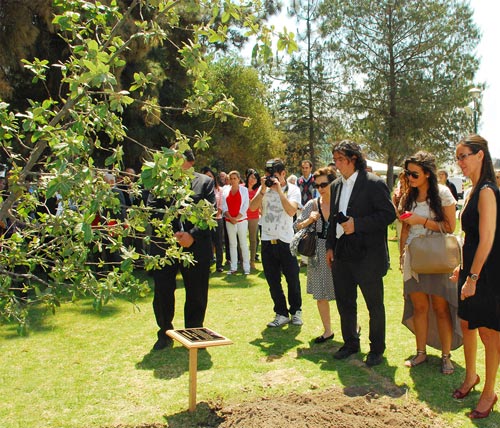 “He had a big heart, divided into clear portions, and CIMMYT occupied a big chunk,” said Martínez’s son Francisco, who noted his father’s supreme love for work and colleagues. He also brought a portion of his father’s ashes and bequeathed them to CIMMYT.
“He had a big heart, divided into clear portions, and CIMMYT occupied a big chunk,” said Martínez’s son Francisco, who noted his father’s supreme love for work and colleagues. He also brought a portion of his father’s ashes and bequeathed them to CIMMYT.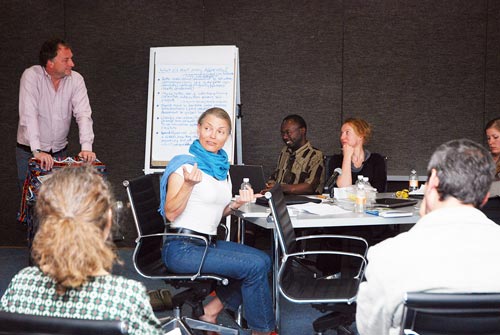 On daily basis, we interact with farmers, extension workers, researchers, seed companies, government officials, and many others. Our work would not be possible without these actors, many of whom focus on bringing new products, new processes, new policies, and new forms of organization into economic use. In their attempts to bring about change in agriculture, these multiple stakeholders are all part of what may be seen as agricultural innovation systems (AIS). However, CIMMYT’s engagement with AIS and its role within innovation platforms was not discussed more closely until recently. To review CIMMYT’s role and current approach to the AIS framework, summarize what has been done, and touch upon future plans,
On daily basis, we interact with farmers, extension workers, researchers, seed companies, government officials, and many others. Our work would not be possible without these actors, many of whom focus on bringing new products, new processes, new policies, and new forms of organization into economic use. In their attempts to bring about change in agriculture, these multiple stakeholders are all part of what may be seen as agricultural innovation systems (AIS). However, CIMMYT’s engagement with AIS and its role within innovation platforms was not discussed more closely until recently. To review CIMMYT’s role and current approach to the AIS framework, summarize what has been done, and touch upon future plans, 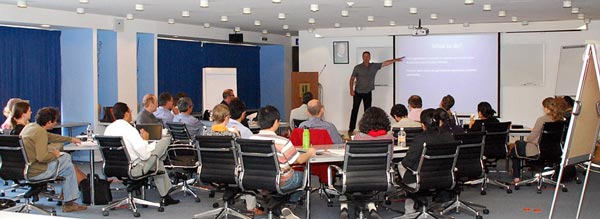
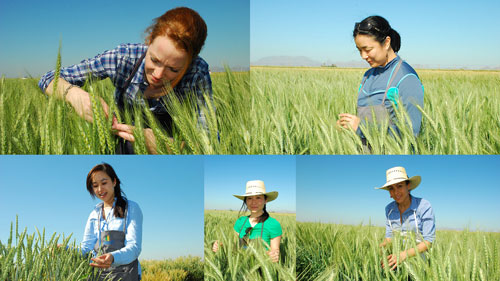
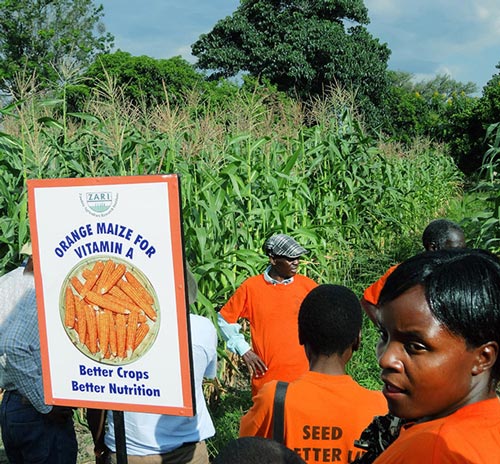 With over 50% of Zambian children under five vitamin A deficient, Zambia faces a major public health problem. This has resulted in several government intervention programs including vitamin A supplementation and sugar fortification, efforts which will soon be complemented by the release of three orange maize hybrids with higher levels of provitamin A carotenoids (compounds converted to vitamin A when consumed) developed by CIMMYT in collaboration with the Zambia Agriculture Research Institute (
With over 50% of Zambian children under five vitamin A deficient, Zambia faces a major public health problem. This has resulted in several government intervention programs including vitamin A supplementation and sugar fortification, efforts which will soon be complemented by the release of three orange maize hybrids with higher levels of provitamin A carotenoids (compounds converted to vitamin A when consumed) developed by CIMMYT in collaboration with the Zambia Agriculture Research Institute (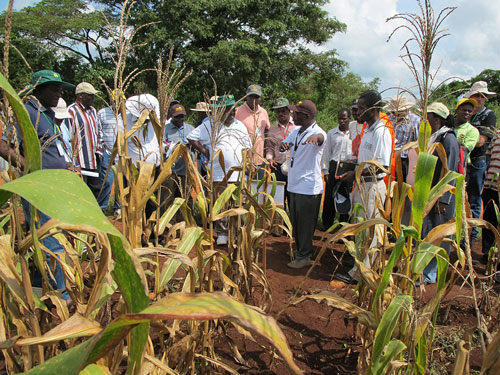 Over 200 researchers, policy makers, donors, seed companies, and NGO representatives from Africa and Australia gathered in Chimoio, Mozambique, during 17-23 March 2013 for the third
Over 200 researchers, policy makers, donors, seed companies, and NGO representatives from Africa and Australia gathered in Chimoio, Mozambique, during 17-23 March 2013 for the third 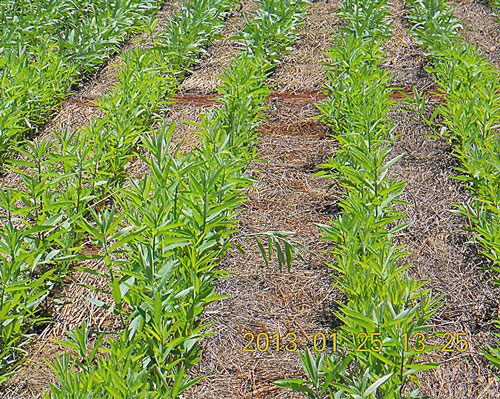 In 2012, three CG centers—the International Livestock Research Institute (
In 2012, three CG centers—the International Livestock Research Institute (
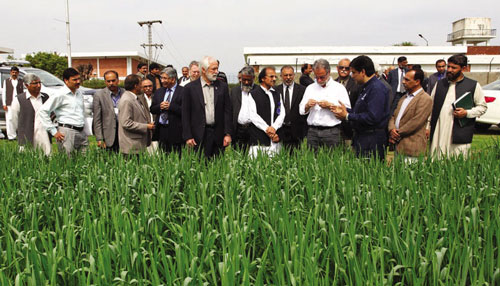 Pakistan ushered in a new era of agricultural research earlier this month when the Ministry of Food Security and Research, CIMMYT,
Pakistan ushered in a new era of agricultural research earlier this month when the Ministry of Food Security and Research, CIMMYT, 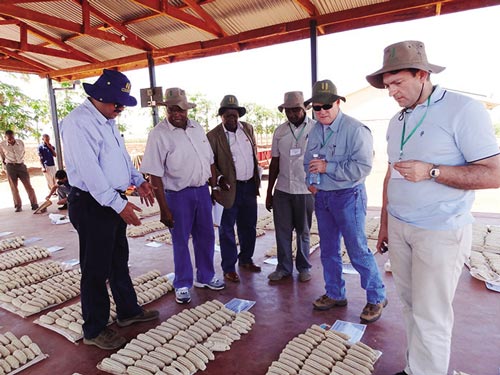 “One of the important ways to increase genetic gains and accelerate the development and deployment of improved varieties is to reduce the time needed for inbred development,” said B.M. Prasanna, CIMMYT’s Global Maize Program director. “The technology would also allow breeders to couple molecular marker-based selection for important traits such as disease resistance and quality at an early generation.” A project planning and review meeting held in Nairobi during 18-19 February 2013 was attended by representatives from national agriculture research systems, Kenya Seed Company, Seed Trade Association of Kenya, University of Hohenheim, the International Institute of Tropical Agriculture (
“One of the important ways to increase genetic gains and accelerate the development and deployment of improved varieties is to reduce the time needed for inbred development,” said B.M. Prasanna, CIMMYT’s Global Maize Program director. “The technology would also allow breeders to couple molecular marker-based selection for important traits such as disease resistance and quality at an early generation.” A project planning and review meeting held in Nairobi during 18-19 February 2013 was attended by representatives from national agriculture research systems, Kenya Seed Company, Seed Trade Association of Kenya, University of Hohenheim, the International Institute of Tropical Agriculture (
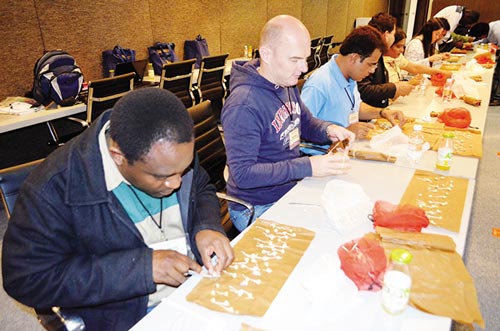 To expand awareness on DH-based breeding and build the capacity of national partners, the CIMMYT Global Maize Program organized the second international training course on doubled haploid technology in maize breeding at El Batán, Mexico, from 4-8 March 2013. Sixteen participants from 10 countries (Ethiopia, India, Kenya, Mexico, Netherlands, Peru, Philippines, South Korea, Thailand, and Zimbabwe) attended the course that provided both theoretical and practical exposure to the DH technology and its applications in maize breeding.
To expand awareness on DH-based breeding and build the capacity of national partners, the CIMMYT Global Maize Program organized the second international training course on doubled haploid technology in maize breeding at El Batán, Mexico, from 4-8 March 2013. Sixteen participants from 10 countries (Ethiopia, India, Kenya, Mexico, Netherlands, Peru, Philippines, South Korea, Thailand, and Zimbabwe) attended the course that provided both theoretical and practical exposure to the DH technology and its applications in maize breeding.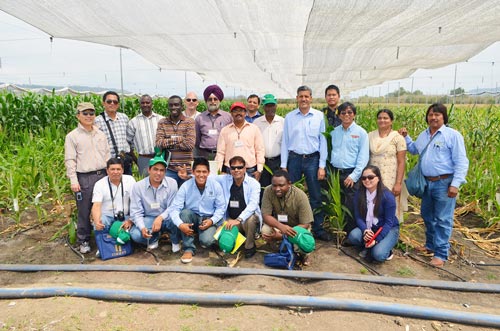
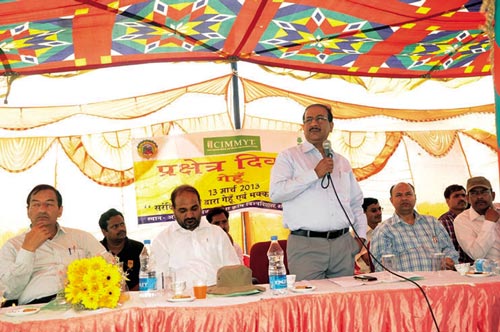 On 13 March 2013, a social learning exercise was organized jointly by Birsa Agricultural University (
On 13 March 2013, a social learning exercise was organized jointly by Birsa Agricultural University (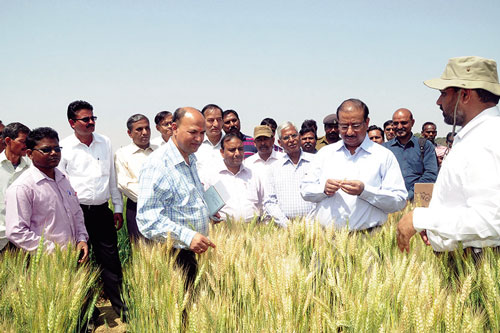 The project aims to conduct farmer participatory trials to eventually achieve mass adoption in the villages of Jharkhand. As the awareness of the project’s successes increases, so does the demand for CA technology. “Local machine manufacturers are encouraged to come forward to assemble and fabricate CA machines adapted to local farmers’ needs,” AK Singh reassured the participants. Further assurance on efficient dissemination of the knowledge and technology among farmers was provided by Chaudhary: “SAMETI utilizes a strong grassroots network of ATMA at district and block levels.” Recognizing the potential of CIMMYT and its dedication to the case, Chaudhary expressed his wish to work more closely with CIMMYT: “With your expertise, we could more efficiently train district and block levels agricultural official s and extension agents, and thus contribute towards state level extension mechanism enrichment.”
The project aims to conduct farmer participatory trials to eventually achieve mass adoption in the villages of Jharkhand. As the awareness of the project’s successes increases, so does the demand for CA technology. “Local machine manufacturers are encouraged to come forward to assemble and fabricate CA machines adapted to local farmers’ needs,” AK Singh reassured the participants. Further assurance on efficient dissemination of the knowledge and technology among farmers was provided by Chaudhary: “SAMETI utilizes a strong grassroots network of ATMA at district and block levels.” Recognizing the potential of CIMMYT and its dedication to the case, Chaudhary expressed his wish to work more closely with CIMMYT: “With your expertise, we could more efficiently train district and block levels agricultural official s and extension agents, and thus contribute towards state level extension mechanism enrichment.”